
Indigo is a deep and rich color close to the color wheel blue, as well as to some variants of ultramarine. It is traditionally regarded as a color in the visible spectrum, as well as one of the seven colors of the rainbow: the color between violet and blue; however, sources differ as to its actual position in the electromagnetic spectrum.

Feathers are epidermal growths that form the distinctive outer covering, or plumage, on dinosaurs, both avian and some non-avian, and possibly other archosauromorphs. They are considered the most complex integumentary structures found in vertebrates and a premier example of a complex evolutionary novelty. They are among the characteristics that distinguish the extant birds from other living groups.
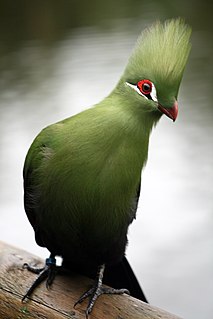
The turacos make up the bird family Musophagidae, which includes plantain-eaters and go-away-birds. In southern Africa both turacos and go-away-birds are commonly known as loeries. They are semi-zygodactylous – the fourth (outer) toe can be switched back and forth. The second and third toes, which always point forward, are conjoined in some species. Musophagids often have prominent crests and long tails; the turacos are noted for peculiar and unique pigments giving them their bright green and red feathers.
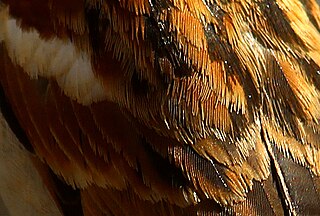
Plumage is a layer of feathers that cover a bird and the pattern, colour, and arrangement of those feathers. The pattern and colours of plumage differ between species and subspecies and may vary with age classes. Within species, there can be different colour morphs. The placement of feathers on a bird is not haphazard, but rather emerge in organized, overlapping rows and groups, and these feather tracts are known by standardized names.

The white-bellied go-away-bird is a bird of eastern Africa in the family Musophagidae, commonly known as turacos.

The red-crested turaco is a turaco, a group of African Otidimorphae birds. It is a frugivorous bird endemic to western Angola. Its call sounds somewhat like a jungle monkey.

Biological pigments, also known simply as pigments or biochromes, are substances produced by living organisms that have a color resulting from selective color absorption. Biological pigments include plant pigments and flower pigments. Many biological structures, such as skin, eyes, feathers, fur and hair contain pigments such as melanin in specialized cells called chromatophores. In some species, pigments accrue over very long periods during an individual's lifespan.
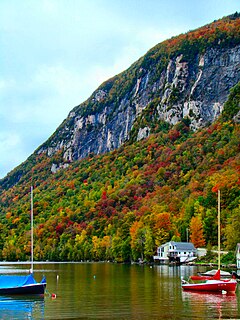
Autumn leaf color is a phenomenon that affects the normal green leaves of many deciduous trees and shrubs by which they take on, during a few weeks in the autumn season, various shades of yellow, orange, red, purple, and brown. The phenomenon is commonly called autumn colours or autumn foliage in British English and fall colors, fall foliage, or simply foliage in American English.

Tauraco is a genus of turacos. It contains the "typical" or green turacos; though their plumage is not always green all over, the presence of significant amounts of turacoverdin-colored plumage generally sets Tauraco species apart from other Musophagidae. Indeed, as opposed to any other known birds, Tauraco turacos are the only living bird taxa that have any significant green pigment whatsoever, as the greens of many parrots etc. are due to structural color, not pigment. Their genus name was derived from a native West African name.

Ross's turaco or Lady Ross's turaco is a mainly bluish-purple African bird of the turaco family, Musophagidae.

Musophaga is a genus of African birds in the family Musophagidae.
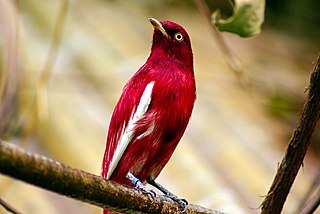
The pompadour cotinga is a species of bird in the family Cotingidae. This species lives in the Amazonian rainforest and has a range that extends across the Amazon Basin and includes Peru, Brazil, Colombia, Venezuela, and the Guianas. The pompadour cotinga is primarily a frugivore but has been known to consume insects on occasion. This species of cotinga is distinct in that the males have a burgundy head and body, bright white wings, and yellow eyes. Like other members of the Cotingidae, this species is sexually dimorphic and the females have a pale grey head and body. Although there are not many documented observations of the nesting behavior of these birds, the males are known to perform elaborate mating displays for the females who then raise the young alone.

Animal coloration is the general appearance of an animal resulting from the reflection or emission of light from its surfaces. Some animals are brightly colored, while others are hard to see. In some species, such as the peafowl, the male has strong patterns, conspicuous colors and is iridescent, while the female is far less visible.

Varieties of the color red may differ in hue, chroma or lightness, or in two or three of these qualities. Variations in value are also called tints and shades, a tint being a red or other hue mixed with white, a shade being mixed with black. A large selection of these various colors is shown below.

Psittacofulvin pigments are responsible for the bright-red, orange, and yellow colours specific to parrots. Psittacofulvin is suspected to be enzymatically derived from carotenoids, which are the pigments other birds use to achieve red and yellow coloring. They consist of linear polyenes terminated by an aldehyde group. Colourful feathers with high levels of psittacofulvin resist feather-degrading Bacillus licheniformis better than white ones.
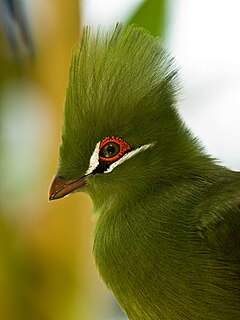
Turacoverdin is a unique copper uroporphyrin pigment responsible for the bright green coloration of several birds of the family Musophagidae, most notably the turaco. It is chemically related to turacin, a red pigment also found almost exclusively in turacos. Turacoverdin is one of the only true green pigments found in birds, as the coloration that appears in most green feathers is due to the unique properties of blue structural coloration in combination with yellow carotenoids. Turacoverdin and turacin were the first ever chemically characterized feather pigments, and turacoverdin was first isolated and described in 1882 by Dr. C.F.W. Krukenberg.

In living creatures, structural coloration is the production of colour by microscopically structured surfaces fine enough to interfere with visible light, sometimes in combination with pigments. For example, peacock tail feathers are pigmented brown, but their microscopic structure makes them also reflect blue, turquoise, and green light, and they are often iridescent.
Sir Arthur Herbert Church was a British chemist, expert on pottery, stones and chemistry of paintings, who discovered turacin in 1869 and several minerals, including the only British cerium mineral. He was also a talented artist and worked as a professor of chemistry at the Agricultural College in Cirencester and then at the Royal Academy of Arts. He wrote extensively on aspects of chemistry in agriculture, art, and daily life.

Solid black plumage color refers to a plumage pattern in chickens characterized by a uniform, black color across all feathers. There are chicken breeds where the typical plumage color is black, such as Australorp, Sumatra, White-Faced Black Spanish, Jersey Giant and others. And there are many other breeds having different color varieties, which also have an extended black variety, such as Leghorn, Minorca, Wyandotte, Orpington, Langshan and others.

Albinism is the "congenital absence of any pigmentation or coloration in a person, animal or plant, resulting in white hair, feathers, scales and skin and pink eyes in mammals, birds, reptiles, amphibians and fish and invertebrates as well." Varied use and interpretation of the terms mean that written reports of albinistic animals can be difficult to verify. Albinism can reduce the survivability of an animal; for example, it has been suggested that albino alligators have an average survival span of only 24 hours due to the lack of protection from UV radiation and their lack of camouflage to avoid predators. Albino animals have characteristic pink or red eyes because the lack of pigment in the iris allows the blood vessels of the retina to be visible. Familiar albino animals include in-bred strains of laboratory animals, but populations of naturally occurring albino animals exist in the wild, e.g. Mexican cave tetra. Albinism is a well-recognized phenomenon in molluscs, both in the shell and in the soft parts. It has been claimed by some, e.g. that "albinism" can occur for a number of reasons aside from inheritance, including genetic mutations, diet, living conditions, age, disease, or injury. However, this is contrary to definitions where the condition is inherited.

















